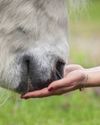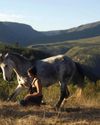Can less training mean more?

We all know that a horse must be in good condition if you want to perform well at competitions. But what is considered good condition? How can we define this, and what does it mean for your daily training practice?
Mostly, we evaluate the intensity of a horse’s training on how we, as a rider or trainer, felt about the training session. Often, this means that we analyse the riding technique of the rider and the response and riding abilities of the horse. These are crucial elements of horse riding, but what about the true physiological response of the horse’s body?
If we want to improve a horse’s balance and work towards collection, we ride various exercises during our training. The question is: do these exercises really improve the strength and power output of the neuromuscular system? Maybe some exercises do, but maybe some are not improving muscle strength, and so are not contributing to shifting the horse’s balance towards collection. Therefore, there is a need for riders and trainers to understand more about the physiological effects of the training of a horse, and when and how the body responds to certain types of training.
What is equine exercise physiology?
Exercise physiology is about analysing and understanding how different body systems, like the cardiovascular, respiratory and neuromuscular systems, react to exercise and how they adapt to different types of exercise. Depending on the discipline and your training goal, you can get different reactions and adaptations of the body.
This story is from the March 2017 edition of HQ magazine.
Start your 7-day Magzter GOLD free trial to access thousands of curated premium stories, and 8,500+ magazines and newspapers.
Already a subscriber ? Sign In
This story is from the March 2017 edition of HQ magazine.
Start your 7-day Magzter GOLD free trial to access thousands of curated premium stories, and 8,500+ magazines and newspapers.
Already a subscriber? Sign In

The Science Behind Tapering
The science behind tapering

Horse Treats
The ultimate guide

Horsey Hair Care
Tips and tricks for a healthy mane and tail

Horsey Hydration- The Importance Of Water In Winter
The importance of water in winter

A Horseback Safari
Abelana Game Reserve

The Psychology Of Riding Performance
Intrinsic motivation, part 7

10 Best Life Lessons From Horses
Life lessons from our horses

Breaking New Ground
The evolution of the Callaho Online Auction

Horse Psychology 101
Part 3: The horse's cognitive abilities

Colic Part 1
An owner’s worst nightmare